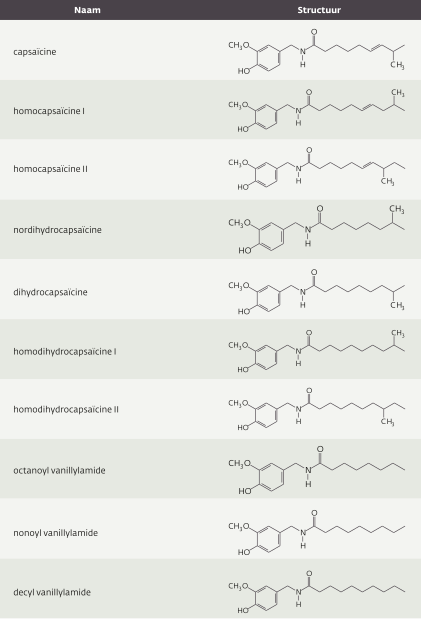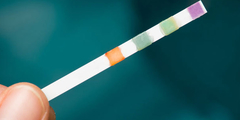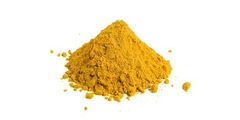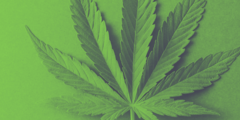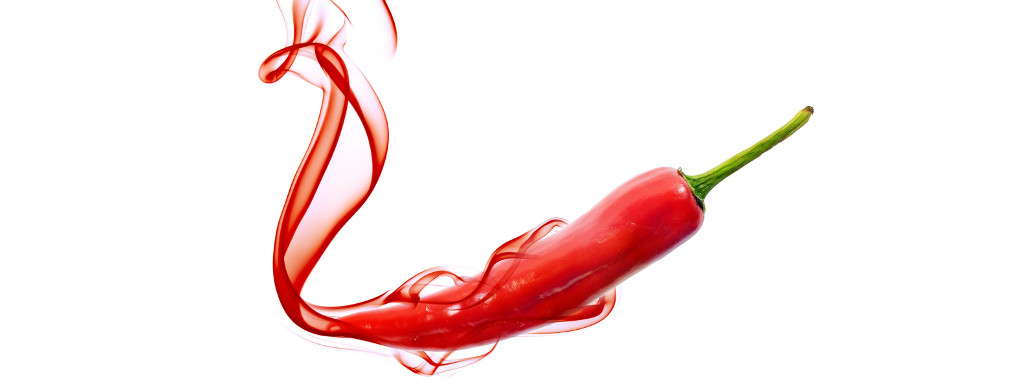
Rode pepers zijn hot, ook in de fytotherapie. De voornaamste actieve stof heet capsaïcine en prikkelt een (pijn)receptor in het lichaam. Rode pepers kunnen nuttig zijn in pijnbestrijding en in de strijd tegen overgewicht. Die laatste toepassing is onder meer gestoeld op het thermogene karakter van capsaïcine. Experimenten tonen ook mogelijkheden bij kanker en de preventie ervan, maar daarover bestaat nog onenigheid.
Beste bezoeker, u heeft geen toegang.
Enkel (web)abonnees hebben toegang tot tijdschriftartikelen. Het webabonnement is nog in de maak.
U kunt zich wel alvast (gratis) registreren en tal van andere webartikelen raadplegen!
Auteur
Verschenen in
Referenties
1. Lv J, Qi L et al; China Kadoorie Biobank Collaborative Group. Consumption of spicy foods and total and cause specific mortality: population based cohort study. BMJ. 2015 Aug 4;351:h3942
2. Forouhi NG. Consumption of hot spicy foods and mortality--is chilli good for your health? BMJ. 2015 Aug 4;351:h4141
3. Aniszewski Tadeusz. Alkaloids, secrets of life. Alkaloid chemistry, biological significance, applications and ecological role. Elsevier Science & Technology (2007)
4. López-Carrillo L, Hernández Avila M, Dubrow R. Chili pepper consumption and gastric cancer in Mexico: a case-control study. Am J Epidemiol. 1994 Feb 1;139(3):263-71
5. López-Carrillo L, López-Cervantes M, Robles-Díaz G et al. Capsaicin consumption, Helicobacter pylori positivity and gastric cancer in Mexico. Int J Cancer. 2003 Aug 20;106(2):277-82
6. Lee JK, Park BJ, Yoo KY, Ahn YO. Dietary factors and stomach cancer: a case-control study in Korea. Int J Epidemiol. 1995 Feb;24(1):33-41
7. Gajalakshmi CK, Shanta V. Lifestyle and risk of stomach cancer: a hospital-based case-control study. Int J Epidemiol. 1996 Dec;25(6):1146-53
8. Serra I, Yamamoto M, Calvo A et al. Association of chili pepper consumption, low socioeconomic status and longstanding gallstones with gallbladder cancer in a Chilean population. Int J Cancer. 2002 Dec 1;102(4):407-11
9. Archer VE, Jones DW. Capsaicin pepper, cancer and ethnicity. Med Hypotheses. 2002 Oct;59(4):450-7
10. Pabalan N, Jarjanazi H, Ozcelik H. The impact of capsaicin intake on risk of developing gastric cancers: a meta-analysis. J Gastrointest Cancer. 2014 Sep;45(3):334-41
11. Bley K, Boorman G, Mohammad B et al. A comprehensive review of the carcinogenic and anticarcinogenic potential of capsaicin. Toxicol Pathol. 2012 Aug;40(6):847-73
12. Clark R, Lee SH. Anticancer properties of capsaicin against human cancer. Anticancer Res. 2016 Mar;36(3):837-43
13. Díaz-Laviada I, Rodríguez-Henche N. The potential antitumor effects of capsaicin. Prog Drug Res. 2014;68:181-208
14. Mason L, Moore RA, Derry S et al. Systematic review of topical capsaicin for the treatment of chronic pain. BMJ. 2004 Apr 24;328(7446):991
15. Backonja M, Wallace MS, Blonsky ER et al. NGX-4010, a high-concentration capsaicin patch, for the treatment of postherpetic neuralgia: a randomised, double-blind study. Lancet Neurol. 2008 Dec;7(12):1106-12
16. Derry S, Sven-Rice A, Cole P et al. Topical capsaicin (high concentration) for chronic neuropathic pain in adults. Cochrane Database Syst Rev. 2013 Feb 28;2:CD007393
17. Schumacher M, Pasvankas G. Topical capsaicin formulations in the management of neuropathic pain. Prog Drug Res. 2014;68:105-28
18. Laslett LL, Jones G. Capsaicin for osteoarthritis pain. Prog Drug Res. 2014;68:277-91
19. Mason L, Moore RA, Derry S et al. Systematic review of topical capsaicin for the treatment of chronic pain. BMJ. 2004 Apr 24;328(7446):991
20. Belza A, Frandsen E, Kondrup J. Body fat loss achieved by stimulation of thermogenesis by a combination of bioactive food ingredients: a placebo-controlled, double-blind 8-week intervention in obese subjects. Int J Obes (Lond). 2007 Jan;31(1):121-30
21. Matsumoto T, Miyawaki C et al. Effects of capsaicin-containing yellow curry sauce on sympathetic nervous system activity and diet-induced thermogenesis in lean and obese young women. J Nutr Sci Vitaminol (Tokyo). 2000 Dec;46(6):309-15
22. Clegg ME, Golsorkhi M, Henry CJ. Combined medium-chain triglyceride and chilli feeding increases diet-induced thermogenesis in normal-weight humans. Eur J Nutr. 2013 Sep;52(6):1579-85
23. Ryan ED, Beck TW, Herda TJ et al. Acute effects of a thermogenic nutritional supplement on energy expenditure and cardiovascular function at rest, during low-intensity exercise, and recovery from exercise. J Strength Cond Res. 2009 May;23(3):807-17
24. Shin KO, Moritani T. Alterations of autonomic nervous activity and energy metabolism by capsaicin ingestion during aerobic exercise in healthy men. J Nutr Sci Vitaminol (Tokyo). 2007 Apr;53(2):124-32
25. Janssens PL, Hursel R, Martens EA et al. Acute effects of capsaicin on energy expenditure and fat oxidation in negative energy balance. PLoS One. 2013 Jul 2;8(7):e67786
26. Yoneshiro T, Aita S, Kawai Y et al. Nonpungent capsaicin analogs (capsinoids) increase energy expenditure through the activation of brown adipose tissue in humans. Am J Clin Nutr. 2012 Apr;95(4):845-50
27. Tomiyama AJ, Hunger JM, Nguyen-Cuu J, Wells C. Misclassification of cardiometabolic health when using body mass index categories in NHANES 2005–2012. International Journal of Obesity, 4 February 2016; doi: 10.1038/ijo.2016.17
28. Leung FW. Capsaicin as an anti-obesity drug. Prog Drug Res. 2014;68:171-9
29. Ohnuki K, Haramizu S, Oki K et al. Administration of capsiate, a non-pungent capsaicin analog, promotes energy metabolism and suppresses body fat accumulation in mice. Biosci Biotechnol Biochem. 2001 Dec;65(12):2735-40
30. Snitker S, Fujishima Y, Shen H et al. Effects of novel capsinoid treatment on fatness and energy metabolism in humans: possible pharmacogenetic implications. Am J Clin Nutr. 2009 Jan;89(1):45-50
31. Tremblay A, Arguin H, Panahi S. Capsaicinoids: a spicy solution to the management of obesity? Int J Obes (Lond). 2015 Dec 21. doi: 10.1038/ijo.2015.253
32. Sun D, Lv J, Chen W et al. Spicy food consumption is associated with adiposity measures among half a million Chinese people: the China Kadoorie Biobank study. BMC Public Health. 2014 Dec 17;14:1293
33. Janssens PL, Hursel R, Martens EA et al. Acute effects of capsaicin on energy expenditure and fat oxidation in negative energy balance. PLoS One. 2013 Jul 2;8(7):e67786
34. Janssens PL, Hursel R, Westerterp-Plantenga MS. Capsaicin increases sensation of fullness in energy balance, and decreases desire to eat after dinner in negative energy balance. Appetite. 2014 Jun;77:44-9
35. Ludy MJ, Mattes RD. The effects of hedonically acceptable red pepper doses on thermogenesis and appetite. Physiol Behav. 2011 Mar 1;102(3-4):251-8
36. Singh U, Bernstein JA. Intranasal capsaicin in management of nonallergic (vasomotor) rhinitis. Prog Drug Res. 2014;68:147-70
37. Patcharatrakul T, Gonlachanvit S. Chili peppers, curcumins, and prebiotics in gastrointestinal health and disease. Curr Gastroenterol Rep. 2016 Apr;18(4):19
38. Boyd K, Shea SM, Patterson JW. The role of capsaicin in dermatology. Prog Drug Res. 2014;68:293-306
39. Metz M, Grundmann S, Ständer S. Pruritus: an overview of current concepts. Vet Dermatol. 2011 Apr;22(2):121-31
40. Deng Y, Huang X, Wu H, Zhao M et al. Some like it hot: The emerging role of spicy food (capsaicin) in autoimmune diseases. Autoimmun Rev. 2016 May;15(5):451-6
41. Fusco BM, Barzoi G, Agrò F. Repeated intranasal capsaicin applications to treat chronic migraine. Br J Anaesth. 2003 Jun;90(6):812
42. Cianchetti C. Capsaicin jelly against migraine pain. Int J Clin Pract. 2010 Mar;64(4):457-9
43. Jankovic B, Loblaw DA, Nam R. Capsaicin may slow PSA doubling time: case report and literature review. Can Urol Assoc J. 2010 Feb;4(1):E9-E11
44. van Avesaat M, Troost FJ et al. Capsaicin-induced satiety is associated with gastrointestinal distress but not with the release of satiety hormones. Am J Clin Nutr. 2016 Feb;103(2):305-13
45. Stohs SJ, Badmaev V. A review of natural stimulant and non-stimulant thermogenic agents. Phytother Res. 2016 Feb 9. doi: 10.1002/ptr.5583
46. Shara M, Stohs SJ, Mukattash TL. Cardiovascular safety of oral p-synephrine (bitter orange) in healthy subjects: a randomized placebo-controlled cross-over clinical trial. Phytother Res. 2016 Mar 7. doi: 10.1002/ptr.5590
47. Stohs SJ, Preuss HG et al. Effects of p-synephrine alone and in combination with selected bioflavonoids on resting metabolism, blood pressure, heart rate and self-reported mood changes. Int J Med Sci. 2011 Apr 28;8(4):295-301
48. Türközü D, Acar Tek N. A Minireview of Effects of Green Tea on Energy Expenditure. Crit Rev Food Sci Nutr. 2015 Jun 19:0
49. Godard MP, Johnson BA, Richmond SR. Body composition and hormonal adaptations associated with forskolin consumption in overweight and obese men. Obes Res. 2005 Aug;13(8):1335-43
50. Onakpoya I, Terry R, Ernst E. The use of green coffee extract as a weight loss supplement: a systematic review and meta-analysis of randomised clinical trials. Gastroenterol Res Pract. 2011;2011. pii: 382852
51. Abidov M, Ramazanov Z, Seifulla R et al. The effects of Xanthigen in the weight management of obese premenopausal women with non-alcoholic fatty liver disease and normal liver fat. Diabetes Obes Metab. 2010 Jan;12(1):72-81
52. Bonet ML, Canas JA et al. Carotenoids and their conversion products in the control of adipocyte function, adiposity and obesity. Arch Biochem Biophys. 2015 Apr 15;572:112-25

